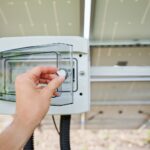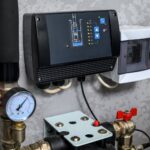Is your smart home hub refusing to connect, leaving your devices in the digital dark? In the fast-paced world of home automation, seamless connectivity between your smart hub and devices is not just a luxury – it’s a necessity. When these connections falter, the convenience of managing your home environment with a tap or voice command becomes a frustrating challenge. Understanding and resolving these connectivity issues is crucial for anyone looking to maintain a fully automated home.
- Identify network and device pairing challenges: Discover the common causes of connection failures that disrupt smart hub performance.
- Network obstacles and solutions: Learn how weak Wi-Fi signals and interference can impact connectivity and explore strategies to boost network reliability.
- Improving hub connection strategies: Delve into practical solutions and advanced pairing techniques to integrate your smart tech effortlessly.
By addressing these issues, you’ll optimize your smart home experience and prevent future connectivity disruptions. Ready to dive into the world of flawless automation? Let’s get started!
Understanding the Smart Home Hub Connection Failure: Network and Device Pairing Challenges
Smart home hubs are central to enhancing the connectivity and functionality of smart homes, but they often encounter connection failures. Understanding the root causes of these failures is crucial for achieving seamless device integration.
A common issue lies in network compatibility problems, where the hub may not effectively communicate with the home network. Often, this is due to discrepancies between the hub’s network requirements and the settings of your existing Wi-Fi setup.
Another frequent culprit of connection troubles is device compatibility. Different smart devices operate on varying communication protocols. A hub might struggle to pair with devices that don’t share a common protocol.
Diagnosing these issues involves checking network settings and ensuring that the smart home hub supports the communication standards of your connected devices. Initial troubleshooting tips include restarting the hub and devices, as well as verifying Wi-Fi credentials.
By addressing these fundamental compatibility challenges, users can enjoy a smoother smart home experience. Optimizing both network and device pairing is key to unlocking the full potential of smart home technology.
Network Issues Affecting Smart Home Hub Connectivity
Network issues are a leading cause of smart home hub connection failures. A weak Wi-Fi signal can severely impact the connectivity between the hub and other devices. Thick walls, interference from other appliances, or an overcrowded network can all lead to reduced signal strength.
To combat these issues, consider placing the hub closer to the Wi-Fi router or using a Wi-Fi extender to boost signal strength. Reducing interference by changing the Wi-Fi channel can also help enhance connectivity.
In addition, network congestion can slow down data transmissions, affecting the performance of your smart home hub. Limit the number of connected devices or invest in a dual-band router to separate devices across different frequencies.
Finally, ensure that your network’s security settings, such as firewalls, are not inadvertently blocking communication between the hub and your smart devices. Properly adjusting these settings can significantly enhance network reliability and improve your smart hub’s performance.
Optimizing Smart Home Hub Connection: Solutions for Network and Device Pairing
Solving smart home hub connection failures involves a combination of strategies to ensure that your devices connect reliably and perform optimally. A key step is ensuring your home network is robust and efficient. Start by evaluating the Wi-Fi signal strength throughout your home. Weak signals can hinder the performance of your smart hubs, causing intermittent connectivity issues.
Enhancing the placement of your Wi-Fi router can be a simple yet effective solution. Position your router in a central location in your home and away from potential sources of interference such as microwaves or thick walls. Consider using a mesh network system to improve coverage in larger homes.
Don’t overlook the importance of regularly updating firmware. Manufacturers often release updates that can improve device compatibility and fix known bugs. Check the settings of your smart hub and connected devices to ensure they are running the latest software. Keeping your software updated can also improve security, protecting your devices against potential vulnerabilities.
Next, explore advanced pairing techniques. Many smart hubs require specific pairing modes and protocols. Ensure that your device settings are configured correctly. Consult the device manual or the manufacturer’s website for specific instructions on troubleshooting and pairing. Enable Bluetooth pairing if applicable, and ensure all devices are within the necessary range during setup.
Lastly, consider device-specific apps or software that provide detailed diagnostics. These tools can offer insights into any underlying connectivity issues and suggest personalized solutions. Addressing these niche challenges will streamline communication between devices, enabling seamless integration of all your smart technologies.
Applying these targeted solutions will not only resolve connection failures but also prepare your smart home system for future expansions, empowering you with a cohesive, connected living environment.
FAQs on Smart Home Hub Connectivity
Why is my smart home hub not connecting to my Wi-Fi?
Ensure the hub is within range of your router and check for possible interference. Try restarting both the hub and router.
What can cause a smart device to fail pairing with the hub?
Compatibility issues and outdated firmware can lead to pairing failures. Verify that your devices are compatible and up-to-date.
How can I improve Wi-Fi signal strength for my smart home hub?
Relocate your router closer to the hub or use a Wi-Fi extender to boost the signal strength.
Is it necessary to update the software regularly on my smart home hub?
Yes, regular updates ensure compatibility and security, enhancing overall performance.
Can interference from other electronic devices affect hub connectivity?
Yes, devices like microwaves and cordless phones can cause interference. Place your hub and router away from such devices.





